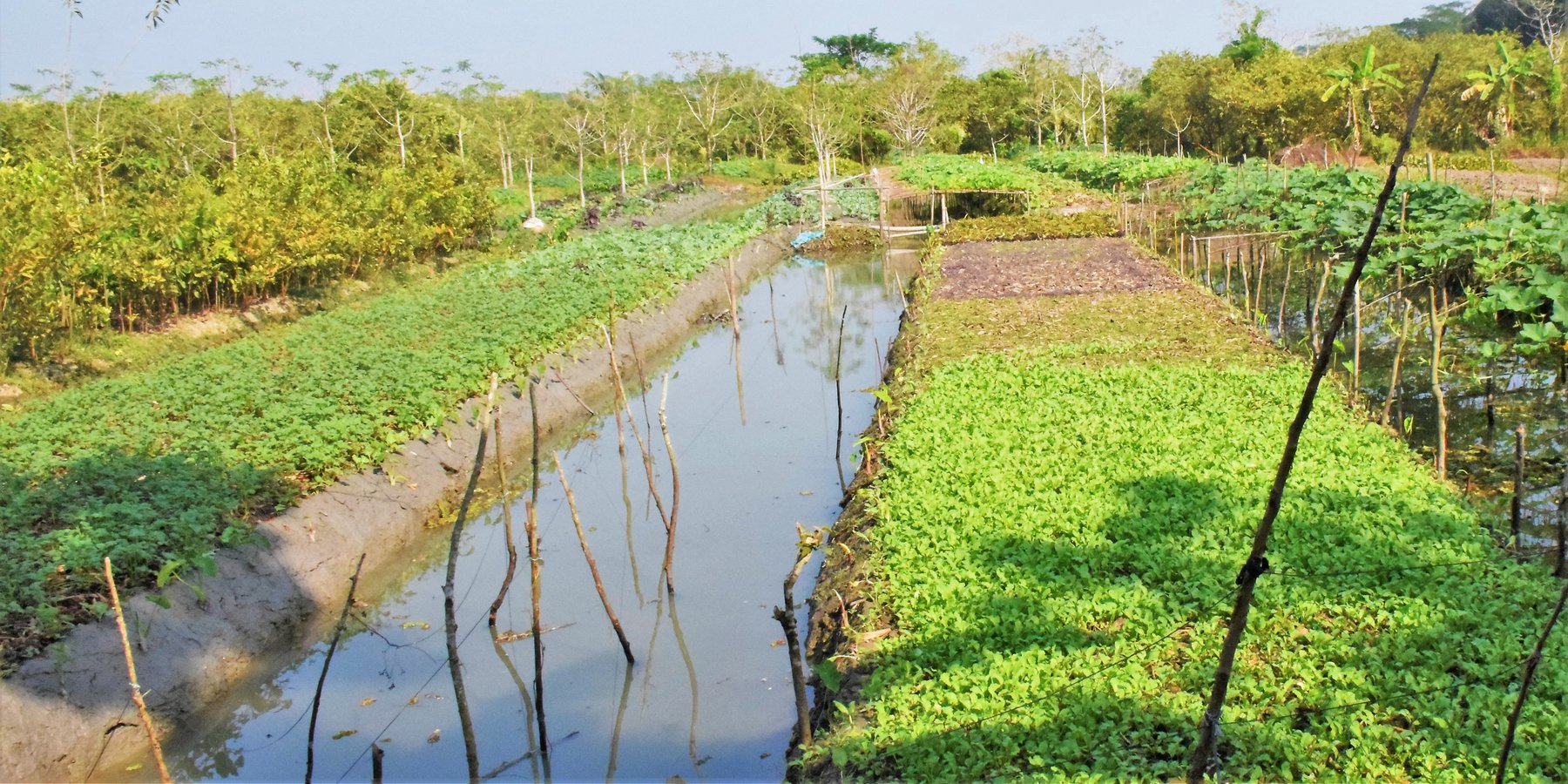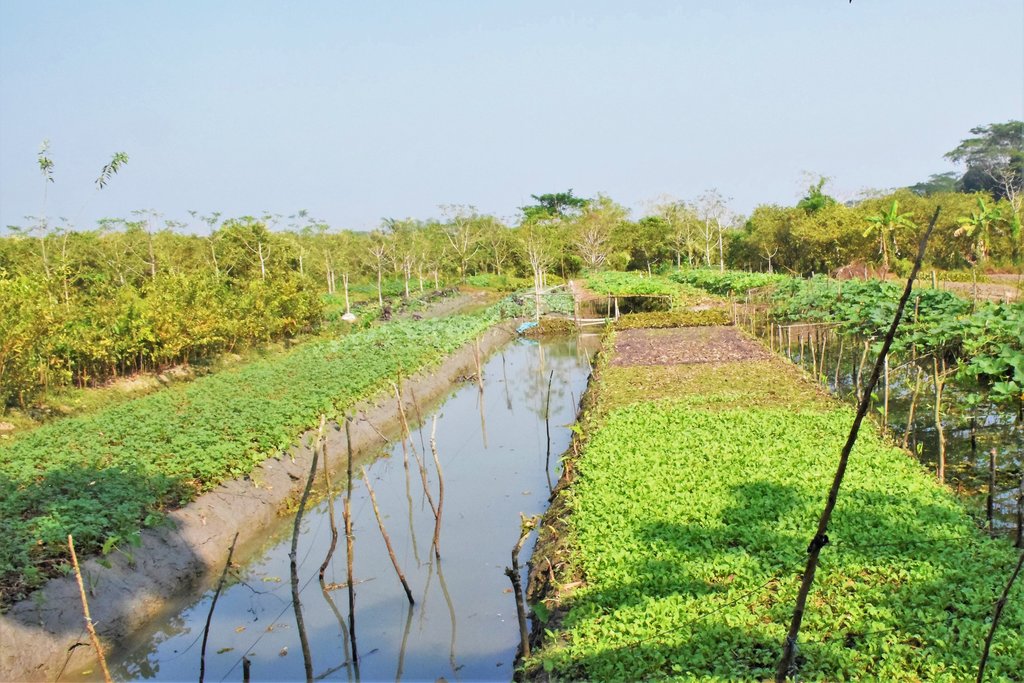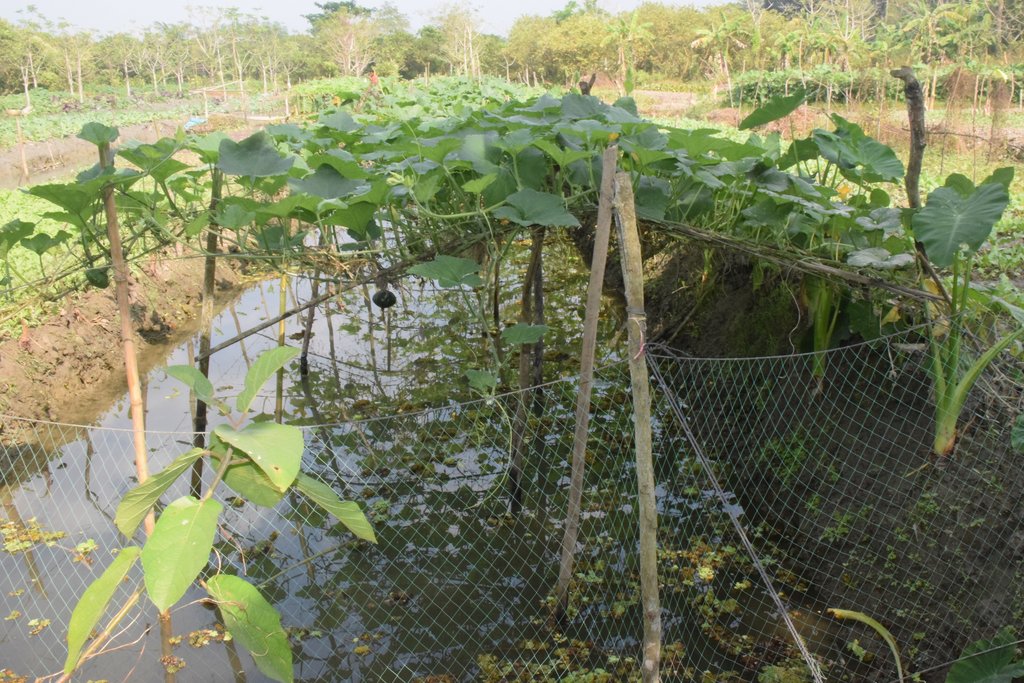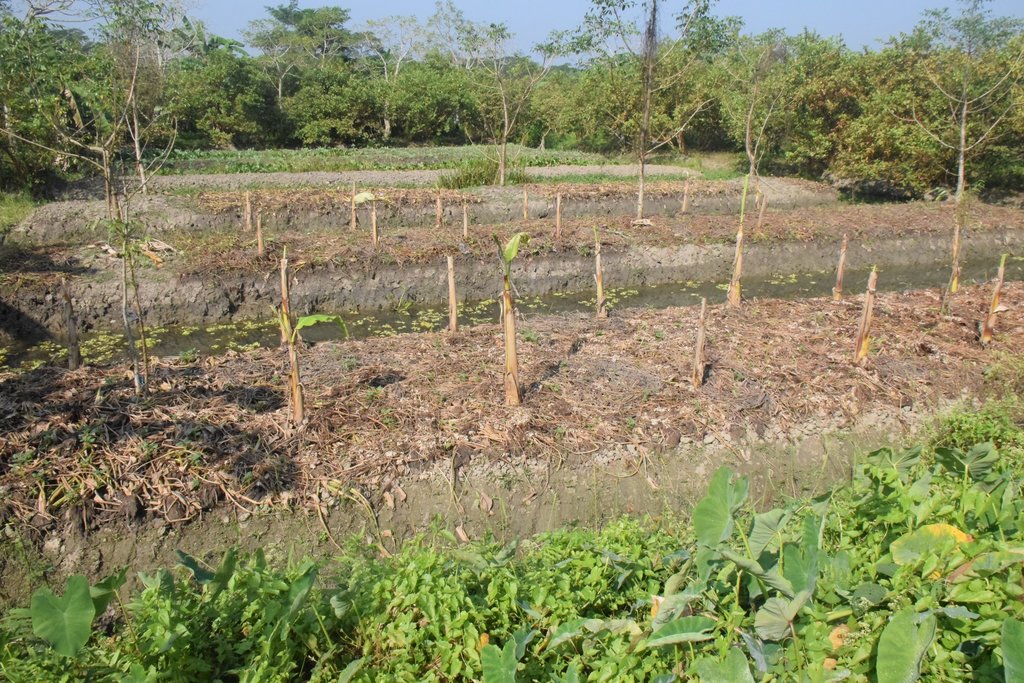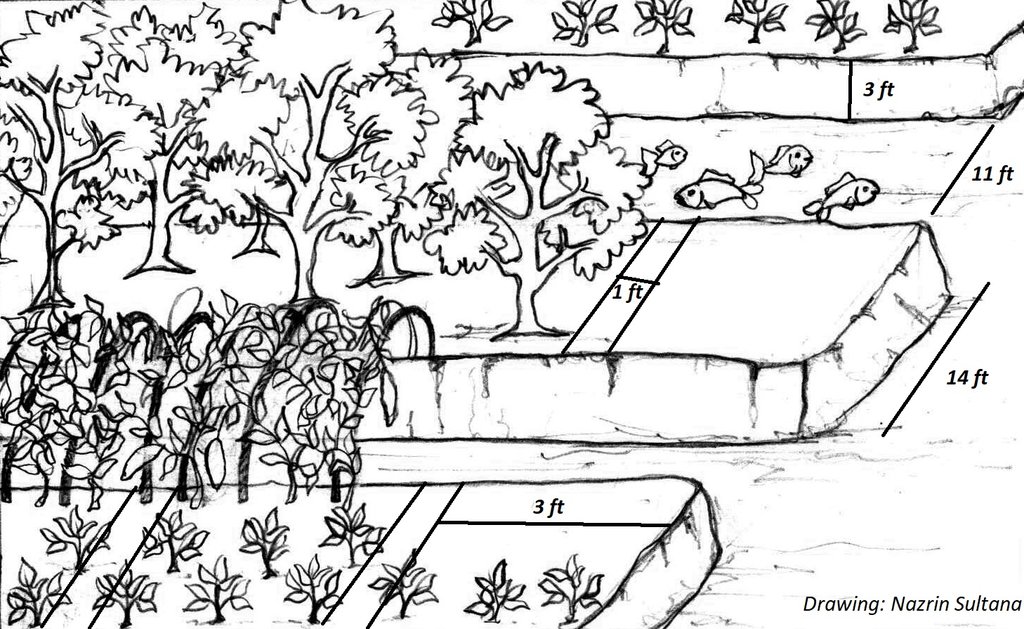Dyke and Ditch multi-cropping system [孟加拉国]
- 创建:
- 更新:
- 编制者: Fazlay Arafat
- 编辑者: –
- 审查者: Nicole Harari, Rima Mekdaschi Studer, Ursula Gaemperli
Kandhi-Berh chas poddhoti
technologies_4227 - 孟加拉国
查看章节
全部展开 全部收起1. 一般信息
1.2 参与该技术评估和文件编制的资源人员和机构的联系方式
关键资源人
土地使用者:
Howlader Abdus Sattar
孟加拉国
土地使用者:
Howlader Najrul Islam
孟加拉国
土地使用者:
Faruk Omaor
孟加拉国
有助于对技术进行记录/评估的项目名称(如相关)
Decision Support for Mainstreaming and Scaling out Sustainable Land Management (GEF-FAO / DS-SLM)有助于对技术进行记录/评估的机构名称(如相关)
Bangladesh Forest Department (Bangladesh Forest Department) - 孟加拉国有助于对技术进行记录/评估的机构名称(如相关)
Soil Resource Development Institute (SRDI) (Soil Resource Development Institute (SRDI)) - 孟加拉国有助于对技术进行记录/评估的机构名称(如相关)
Department of Agricultural Extension (DAE) - 孟加拉国1.3 关于使用通过WOCAT记录的数据的条件
编制者和关键资源人员接受有关使用通过WOCAT记录数据的条件。:
是
1.4 所述技术的可持续性声明
这里所描述的技术在土地退化方面是否存在问题,导致无法被认为是一种可持续的土地管理技术?:
否
2. SLM技术的说明
2.1 技术简介
技术定义:
Landform changes to dyke and ditch to introduce multiple crops.
2.2 技术的详细说明
说明:
Marshy land covers most of the area of southern Bangladesh in the estuaries of the big rivers, including Swarupkathi Upazila. This area typically floods for more than 9 months, is perennially wet, and is covered by Hogla (Typha), Reed plant, and weeds. Crop cultivation has been difficult due to unfavourable drainage conditions. Local people previously cultivated paddy only in small areas by clearing the swamp vegetation. Now, however, some of the marshy land has been converted to a dyke and ditch multi-cropping system, which has been practiced for the last 200 years. Through this practice, the marshlands have provided valuable harvests for generations and currently yield vegetables, fruits, timber and fishes for farmers and that support local livelihoods. The marshland ecosystem, that converted to terrestrial ecosystem now support habitat for a wide range of flora and fauna. The technology reduces the pressure on arable land through construction of dykes which also plays a crucial role in flood mitigation. The continuous series of dykes and ditches with diverse vegetation increases the aesthetic beauty of the region and conserve biodiversity as well.
The dykes are elevated beds of soil constructed to 4-6 feet height and 12-14 feet width. The dykes are constructed with soils collected from ditches and on the top of the bed water hyacinth composed are used. Along with increasing fertility, water hyacinth compost also increases the soil holding capacity of the dykes. Though water hyacinth is normally one of the most dangerous invasive species, it can be converted to useful resource by this system. The ditches are 10-11 feet wide canals and deep enough for fish culture. According to size of land owned by farmer the length of each dyke and ditch varies. All the ditches are interconnected with a regular flow of water. Once the dyke preparation is complete, crops including brinjal (eggplant), turnip, red amaranth, coriander, spinach, cowpea, chili, cornflower, tomato, papaya are planted. On the bed, 1 foot wide drain is constructed after every 3 feet intervals. Creepers and vines are planted on sticks along the sides of the dyke to prevent erosion. Trellis crops like bottle gourd, bitter gourd, ash gourd, sweet gourd, cucumber, etc. are cultivated in between two dykes and over the ditches. Guava, Hog plum, banana, lemon, pineapples and other fruit trees planted are in the bed after three years of establishment. Timber trees are also introduced in the dykes over time though some beds are only managed for crop cultivation. Through this way, they establish a multi-crop and agro-forestry system. In the ditches, farmers cultivate local fish varieties that generate extra income for them. Water hyacinth also managed in the ditch that used as fertilizer in the bed. Farmer add soil to the dyke from the ditches once in every year to raise the dyke and make it stable. The local community also developed a large floating market of guava, which now attracts tourism in this area and facilitates alternate income.
The initial investment of establishing dyke and ditch technology is expensive due to huge labour requirement for dyke preparation and often difficult for farmers to manage the required money. Usually they take loans from neighbours or micro credit organizations with high interest to initiate the work. Almost 80% of the households are involved with micro credits in Swarupkathi because loans from the national bank is much more time-consuming. If the farmers can get easier access to loan and marketing facilities from the government, they will benefit more from the dyke and ditch system.
2.3 技术照片
关于照片的一般说明:
These are the photos of 1st year of dyke and ditch cropping system; vegetables will be replaced eventually by Guava/Hog Plum etc.
2.5 已应用该技术的、本评估所涵盖的国家/地区/地点
国家:
孟加拉国
区域/州/省:
Barishal Division
有关地点的进一步说明:
Atghor Kuriana, Swarupkathi, Pirojpur
具体说明该技术的分布:
- 均匀地分布在一个区域
如果不知道精确的区域,请注明大致覆盖的区域:
- 100-1,000 平方千米
技术现场是否位于永久保护区?:
否
Map
×2.6 实施日期
如果不知道确切的年份,请说明大概的日期:
- 50多年前(传统)
2.7 技术介绍
详细说明该技术是如何引入的:
- 作为传统系统的一部分(> 50 年)
注释(项目类型等):
This practice spread out through local community.
3. SLM技术的分类
3.1 该技术的主要目的
- 改良生产
- 减少、预防、恢复土地退化
- 降低灾害风险
- 创造有益的经济影响
3.2 应用该技术的当前土地利用类型
同一土地单元内混合使用的土地::
是
具体说明混合土地使用(作物/放牧/树木):
- 农林业

农田
- 一年一作
- 多年一作(非木材)
- 乔木与灌木的种植
年作 - 具体指明作物:
- 根/块茎作物 - 土豆
- 蔬菜 - 叶菜(色拉、卷心菜、菠菜和其他)
- 蔬菜 - 香瓜、南瓜、南瓜或葫芦
多年生(非木质)作物 - 指定作物:
- 香蕉/芭蕉/蕉麻
- 菠萝
- 甘蔗
乔木和灌木种植 - 指定作物:
- 水果、其他
- 芒果、山竹果、番石榴
- 木瓜
每年的生长季节数:
- 3
采用间作制度了吗?:
是
如果是,说明哪些作物是间作的:
Radish, Cabbage, Cauliflower, Chili, Indian Spinach, Red amaranth, Coriander, Potato, Taro, Bottle gourd, Sweet gourd, Brinjal, Yard long bean, Bitter gourd etc. mixed with Sugarcane, Guava, Hog plum, Coconut, Betel nut. In the ditches between the horticultural dykes, some farmers also practice fish farming with local fish verities.
采用轮作制度了吗?:
否
注释:
As closest cropping system agroforestry is selected. The crop composition is seasonal vegetables followed by horticulture crops.
3.3 由于技术的实施,土地使用是否发生了变化?
由于技术的实施,土地使用是否发生了变化?:
- 是(请在技术实施前填写以下有关土地利用的问题)
同一土地单元内混合使用的土地::
否

农田
- 一年一作
年作 - 具体指明作物:
- 谷类 - 水稻(湿地)
采用间作制度了吗?:
否
采用轮作制度了吗?:
否
3.4 供水
该技术所应用土地的供水:
- 混合雨水灌溉
注释:
Manual irrigation practiced as supplementary.
3.5 该技术所属的SLM组
- 农业林学
- 土壤肥力综合管理
- 湿地保护/管理
- Agri-horticulture
3.6 包含该技术的可持续土地管理措施

农艺措施
- A2:有机质/土壤肥力

结构措施
- S11:其它

管理措施
- M1:改变土地使用类型
注释:
Ditch and dyke establishment to avoid prolonged water logging situation.
3.7 该技术强调的主要土地退化类型

水质恶化
- Hs:地表水良变化
注释:
Prolonged water logging was the problem of this area. Through establishment of ditch and dyke system the community overcome the situation and is now growing their crops year round.
3.8 防止、减少或恢复土地退化
具体数量名该技术与土地退化有关的目标:
- 减少土地退化
注释:
Through dyke and ditch method, crop production was increased tough total cropping area was decreased due to preparation of ditch
4. 技术规范、实施活动、投入和成本
4.1 该技术的技术图纸
技术规范(与技术图纸相关):
Width of dyke: 12-14 ft, (3.6m-4m)
Height of dyke: 3-4 ft from water surface (1-1.2m)
Width of ditch: 10-11 ft (3-3.4m)
Width of drain in bed: 1 ft (30cm)
Interval of drain in bed: 3 ft (1m)
作者:
Nazrin Sultana
日期:
17/04/2019
4.2 有关投入和成本计算的一般信息
具体说明成本和投入是如何计算的:
- 每个技术区域
注明尺寸和面积单位:
1 acre
其它/国家货币(具体说明):
BDT
如相关,注明美元与当地货币的汇率(例如1美元=79.9巴西雷亚尔):1美元=:
84.0
注明雇用劳工的每日平均工资成本:
BDT 500
4.3 技术建立活动
| 活动 | 时间(季度) | |
|---|---|---|
| 1. | Earth work (dyke preparation, bed leveling with water hyacinth compost, drain preparation on bed) | December to February |
| 2. | Seasonal/annual planting of crops and vegetables | Seasonal |
| 3. | Planting of horticultural tree and shrub species after 2-3 years of crop cultivation | Jun-July |
4.4 技术建立所需要的费用和投入
| 对投入进行具体说明 | 单位 | 数量 | 单位成本 | 每项投入的总成本 | 土地使用者承担的成本% | |
|---|---|---|---|---|---|---|
| 劳动力 | Earth work (dyke preparation, bed leveling with water hyacinth compost, drain preparation on bed) | person-days | 200.0 | 500.0 | 100000.0 | 100.0 |
| 劳动力 | Cultivation | person-day | 100.0 | 500.0 | 50000.0 | 100.0 |
| 劳动力 | Weeding | person-day | 60.0 | 500.0 | 30000.0 | 100.0 |
| 设备 | Spade | pieces | 2.0 | 250.0 | 500.0 | 100.0 |
| 设备 | Weeder (manual weeding tool) | pieces | 2.0 | 150.0 | 300.0 | 100.0 |
| 设备 | Bucket | pieces | 2.0 | 150.0 | 300.0 | 100.0 |
| 设备 | Net (to support trellis crops cultivation in between dykes)) | kg | 20.0 | 60.0 | 1200.0 | 100.0 |
| 设备 | Bamboo sticks (to support the nets and creepers vegetable) | pieces | 200.0 | 2.0 | 400.0 | 100.0 |
| 植物材料 | Seeds (needed over first 2-3 years of establishment) | kg | 0.5 | 2000.0 | 1000.0 | 100.0 |
| 植物材料 | Seedling (needed over first 2-3 years of establishment) | pieces | 300.0 | 20.0 | 6000.0 | 100.0 |
| 肥料和杀菌剂 | T.S.P | kg | 66.0 | 22.0 | 1452.0 | 100.0 |
| 肥料和杀菌剂 | Urea | kg | 66.0 | 16.0 | 1056.0 | 100.0 |
| 肥料和杀菌剂 | MoP | kg | 22.0 | 15.0 | 330.0 | 100.0 |
| 肥料和杀菌剂 | Pesticides | litre | 1.0 | 5000.0 | 5000.0 | 100.0 |
| 技术建立所需总成本 | 197538.0 | |||||
| 技术建立总成本,美元 | 2351.64 | |||||
注释:
Earth work is the prime establishment cost of this technology and others are the regular cropping cost
4.5 维护/经常性活动
| 活动 | 时间/频率 | |
|---|---|---|
| 1. | Dyke management (add soil and water hyacinth to the dyke, bed leveling, drainage system on bed) | March-April |
4.6 维护/经常性活动所需要的费用和投入(每年)
| 对投入进行具体说明 | 单位 | 数量 | 单位成本 | 每项投入的总成本 | 土地使用者承担的成本% | |
|---|---|---|---|---|---|---|
| 劳动力 | Dyke management (add soil and water hyacinth to the dyke, bed leveling, drainage system on bed) | person-days | 66.0 | 500.0 | 33000.0 | 100.0 |
| 设备 | Spade | pieces | 2.0 | 250.0 | 500.0 | 100.0 |
| 设备 | Bucket | pieces | 2.0 | 150.0 | 300.0 | 100.0 |
| 技术维护所需总成本 | 33800.0 | |||||
| 技术维护总成本,美元 | 402.38 | |||||
4.7 影响成本的最重要因素
描述影响成本的最决定性因素:
Labor cost
5. 自然和人文环境
5.1 气候
年降雨量
- < 250毫米
- 251-500毫米
- 501-750毫米
- 751-1,000毫米
- 1,001-1,500毫米
- 1,501-2,000毫米
- 2,001-3,000毫米
- 3,001-4,000毫米
- > 4,000毫米
指定年平均降雨量(若已知),单位为mm:
2184.00
农业气候带
- 半湿润
5.2 地形
平均坡度:
- 水平(0-2%)
- 缓降(3-5%)
- 平缓(6-10%)
- 滚坡(11-15%)
- 崎岖(16-30%)
- 陡峭(31-60%)
- 非常陡峭(>60%)
地形:
- 高原/平原
- 山脊
- 山坡
- 山地斜坡
- 麓坡
- 谷底
垂直分布带:
- 0-100 m a.s.l.
- 101-500 m a.s.l.
- 501-1,000 m a.s.l.
- 1,001-1,500 m a.s.l.
- 1,501-2,000 m a.s.l.
- 2,001-2,500 m a.s.l.
- 2,501-3,000 m a.s.l.
- 3,001-4,000 m a.s.l.
- > 4,000 m a.s.l.
说明该技术是否专门应用于:
- 不相关
5.3 土壤
平均土层深度:
- 非常浅(0-20厘米)
- 浅(21-50厘米)
- 中等深度(51-80厘米)
- 深(81-120厘米)
- 非常深(> 120厘米)
土壤质地(表土):
- 细粒/重质(粘土)
土壤质地(地表以下> 20厘米):
- 细粒/重质(粘土)
表土有机质:
- 中(1-3%)
5.4 水资源可用性和质量
地下水位表:
< 5米
地表水的可用性:
好
水质(未处理):
仅供农业使用(灌溉)
水质请参考::
地表水
水的盐度有问题吗?:
否
该区域正在发生洪水吗?:
是
规律性:
偶然
5.5 生物多样性
物种多样性:
- 中等
栖息地多样性:
- 中等
5.6 应用该技术的土地使用者的特征
定栖或游牧:
- 定栖的
生产系统的市场定位:
- 混合(生计/商业)
非农收入:
- 收入的10-50%
相对财富水平:
- 贫瘠
个人或集体:
- 个人/家庭
机械化水平:
- 手工作业
性别:
- 女人
- 男人
土地使用者的年龄:
- 中年人
5.7 应用该技术的土地使用者使用的平均土地面积
- < 0.5 公顷
- 0.5-1 公顷
- 1-2 公顷
- 2-5公顷
- 5-15公顷
- 15-50公顷
- 50-100公顷
- 100-500公顷
- 500-1,000公顷
- 1,000-10,000公顷
- > 10,000公顷
这被认为是小规模、中规模还是大规模的(参照当地实际情况)?:
- 小规模的
- 中等规模的
5.8 土地所有权、土地使用权和水使用权
土地所有权:
- 个人,未命名
- 个人,有命名
土地使用权:
- 租赁
- 个人
用水权:
- 自由进入(无组织)
土地使用权是否基于传统的法律制度?:
是
具体说明:
Law of inheritance
5.9 进入服务和基础设施的通道
健康:
- 贫瘠
- 适度的
- 好
教育:
- 贫瘠
- 适度的
- 好
技术援助:
- 贫瘠
- 适度的
- 好
就业(例如非农):
- 贫瘠
- 适度的
- 好
市场:
- 贫瘠
- 适度的
- 好
能源:
- 贫瘠
- 适度的
- 好
道路和交通:
- 贫瘠
- 适度的
- 好
饮用水和卫生设施:
- 贫瘠
- 适度的
- 好
金融服务:
- 贫瘠
- 适度的
- 好
6. 影响和结论性说明
6.1 该技术的现场影响
社会经济效应
生产
作物生产
作物质量
生产故障风险
产品多样性
生产区域
土地管理
收入和成本
农业投入费用
农业收入
收入来源的多样性
经济差异
注释/具体说明:
economic disparities decreased as marginal and landless farmers get the opportunity to grow crops on dykes and fish in ditches
工作量
社会文化影响
食品安全/自给自足
健康状况
注释/具体说明:
through ditch and dyke cultivation technique local community get access to vegetable and fish source
文化机会
娱乐机会
社区机构
注释/具体说明:
local farmers are now forming groups and working together to transport their crops to market
SLM/土地退化知识
社会经济弱势群体的情况
注释/具体说明:
landless farmers get opportunity to work as paid labor
生态影响
水循环/径流
蒸发
注释/具体说明:
evaporation decreased due to the presence of vegetation in dykes
土壤
土壤水分
注释/具体说明:
Soil moisture decreased in dykes and before it was too swampy for agricultural activities
土壤覆盖层
土壤流失
土壤堆积
养分循环/补给
土壤有机物/地下C
生物多样性:植被、动物
植被覆盖
生物量/地上C
植物多样性
有益物种
栖息地多样性
害虫/疾病控制
减少气候和灾害风险
洪水影响
碳和温室气体的排放
风速
微气候
6.2 该技术的场外影响已经显现
温室气体的影响
6.3 技术对渐变气候以及与气候相关的极端情况/灾害的暴露和敏感性(土地使用者认为的极端情况/灾害)
渐变气候
渐变气候
| 季节 | 增加或减少 | 该技术是如何应对的? | |
|---|---|---|---|
| 年温度 | 增加 | 好 | |
| 季节性温度 | 夏季 | 增加 | 好 |
| 年降雨量 | 减少 | 好 | |
| 季雨量 | 湿季/雨季 | 减少 | 好 |
气候有关的极端情况(灾害)
气象灾害
| 该技术是如何应对的? | |
|---|---|
| 热带风暴 | 好 |
水文灾害
| 该技术是如何应对的? | |
|---|---|
| 比较和缓的(河道)洪水 | 非常好 |
6.4 成本效益分析
技术收益与技术建立成本相比如何(从土地使用者的角度看)?
短期回报:
稍微积极
长期回报:
非常积极
技术收益与技术维护成本/经常性成本相比如何(从土地使用者的角度看)?
短期回报:
积极
长期回报:
非常积极
6.5 技术采用
- > 50%
在所有采用这项技术的人当中,有多少人是自发的,即未获得任何物质奖励/付款?:
- 91-100%
6.6 适应
最近是否对该技术进行了修改以适应不断变化的条件?:
否
6.7 该技术的优点/长处/机会
| 土地使用者眼中的长处/优势/机会 |
|---|
| 1. Introduction of multi crops. |
| 2. Maintaining daily households nutrition needs. |
| 3. Support natural fish catching. |
| 4. Improve economic condition of local communities. |
| 5. Reduce risk of crop failure. |
| 6. Improved access to health and education. |
| 编制者或其他关键资源人员认为的长处/优势/机会 |
|---|
| Socio-economic condition improved |
| Improved soil nutrient balance |
| Increase crop intensity and diversity |
| Reduce green house gas emission |
| Improved biodiversity |
6.8 技术的弱点/缺点/风险及其克服方法
| 土地使用者认为的弱点/缺点/风险 | 如何克服它们? |
|---|---|
| Establishment cost is high | Easy loan facilities by government |
| Unavailability of labor | Standard payment for labor |
| Lack of post harvest processing/storage facility | Government initiatives to establish processing and store house |
| Late harvesting of crops and eventually low price for sale | Use high yielding and early crop varieties |
| 编制者或其他关键资源人员认为的弱点/缺点/风险 | 如何克服它们? |
|---|---|
| Absence of perfect market | Through government initiative facilitate a market place |
| Grazing hampers the stand at the initial stage | Community awareness |
7. 参考和链接
7.1 信息的方法/来源
- 实地考察、实地调查
Number of informants: 12
- 与土地使用者的访谈
Number of informants: 10
- 与SLM专业人员/专家的访谈
Number of informants: 02
(现场)数据是什么时候汇编的?:
25/11/2018
7.2 参考可用出版物
标题、作者、年份、ISBN:
Rahman, M. (2014). Framing Ecosystem-based Adaptation to Climate Change: Applicability in the Coast of Bangladesh, Dhaka, Bangladesh: IUCN, x+43pp.
可以从哪里获得?成本如何?
Mangrove for Future, Bangladesh.
7.3 链接到网络上的相关信息
标题/说明:
Ditch-and-dyke schemes for year-round cultivation
URL:
www.mangrovesforthefuture.org/assets/Repository/Documents/Framing-ecosystem-based-adaptation-BangladeshcIUCN2014.pdf
7.4 一般注释
The WOCAT questionnaire covers all the technical aspect of this practice.
链接和模块
全部展开 全部收起链接
无链接
模块
无模块


